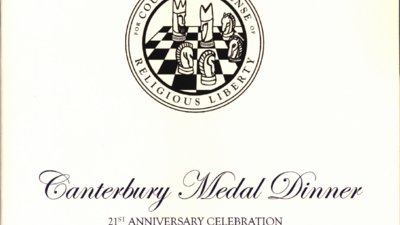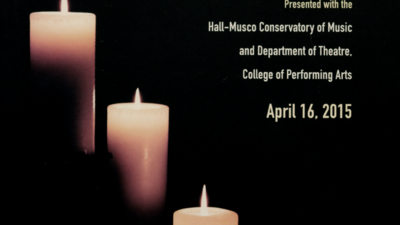Letter from Ronald Reagan to Elie Wiesel congratulating him on the 1986 Nobel Peace Prize
Title
Date
Contributor
Summary
This letter, dated October 15, 1986, is from Ronald Reagan (and Nancy Reagan) to Professor Elie Wiesel, extending congratulations on his 1986 Nobel Peace Prize. Reagan emphasizes the importance of remembering historical lessons, particularly the Holocaust, to secure future peace. He praises Wiesel's life as a powerful testament to truth, recognizing his dedication to the memory of Holocaust victims, including his own family. The letter highlights Wiesel's role in demonstrating humanity's capacity to resist evil and advocate for peace, asserting that his award is a fitting acknowledgment of his profound service to humanity.
More Sources Like This

This document is the program for the 21st Annual Canterbury Medal Dinner, held on May 12, 2016, at The Pierre Hotel in New York City. The event is hosted by The Becket Fund for Religious Liberty and honors Armando Valladares, recognized as a poet, artist, human rights activist, and former political prisoner. The program includes an overview of The Becket Fund and the Canterbury Medal, profiles of the Master of Ceremonies (Kristina Arriaga de Bucholz), those giving opening remarks (William P. Mumma), invocation (Fr. Paul Scalia), tribute to the Medalist (Elie Wiesel), and benediction (Elder Gary E. Stevenson). It details Valladares's biography, highlighting his 22 years as a political prisoner in Cuba and his advocacy for human rights and religious liberty. The program also lists past Canterbury Medalists, Dinner Chairs (Tony and Christie de Nicola), honorary vice chairmen, Becket Fund Board of Directors, and various sponsors and contributors, including organizations like The Knights of Columbus, EWTN Global Catholic Network, The Heritage Foundation, and The Church of Jesus Christ of Latter-day Saints. A dinner menu is also included.

This document is a program for "An Evening of Holocaust Remembrance" held at Chapman University on April 16, 2015. The event, presented by the Hall-Musco Conservatory of Music, Department of Theatre, and the Rodgers Center for Holocaust Education, featured a series of performances, readings, and reflections. Highlights included a welcome by Dr. Daniele Struppa, musical excerpts by various composers performed by artists such as Iman Khosrowpour and Summer Hassan, and readings from the works of Elie Wiesel by students and faculty. The program also included a lighting of commemorative candles and reflections by Dr. Marilyn Harran and Dr. Gail Stearns, with Nobel Peace Prize Laureate Elie Wiesel present as a Distinguished Presidential Fellow. The document details biographies of the speakers, performers, and production team, emphasizing the event's focus on memory, justice, and human rights in the context of the Holocaust, commemorating the millions who perished and honoring survivors and liberators.
of
Tibor Baranski
Tibor Baranski, honored as a Righteous Among the Nations by YadVashem, was born June 11, 1922 in Budapest, Hungary. He was educated in Hungarian Gymnasia and aware of rising antisemitism by 1938. He studied for the priesthood in Vesprem in 1940 and in Kassa (Kosice) in 1943. He learned of Nazi extermination plans through church channels. He returned to Budapest October 20, 1944 as the Russian army drew near.
Mr. Baranski provides a very detailed and extensive description of several rescues of Jews, from October to December, 1944, at the request of Angelo Rotta, the papal nuncio, who acted as a representative of the Vatican under orders of Pope Pius XII. He rescued Jews from a transit camp to safe houses in Budapest. He worked with representatives from neutral nations and the Red Cross to stop deportations from Hegyeshalom, using protective letters (Schutzpasse), and safe houses to shelter almost 6000 Jews. He was almost executed several times. He provides details of efforts to hide Jews by Christian groups and individuals. He credits Elizabeth Kemeny, Raoul Wallenberg, Prince Esterhazy, Father Hummel and a number of priests and nuns who helped in the rescue. He talks about his encounter with Wallenberg and why he was arrested by the Russians.
Mr. Baranski was arrested by the Russians December 30, 1944 and sent on a deathmarch from Budapest to Szekszarv. Saved by a Russian soldier, he returned to Budapest. He worked with an underground movement opposed to communist rule and was arrested by the Russians again November 1948. He describes postwar life in Hungary under communist rule.
He discusses Hungarian-German relations, Miklo Horthy’s attitude towards Jews and Nazis, German occupation of Hungary, and the role of the Vatican in great detail based on his contacts. He entered the United States in 1961 and became a member of the U.S. Holocaust Memorial Council.
Note: Audiotaped interviews of Per Anger and Elizabeth Kemeny Fuchs (referred to by Tibor Baranski) are at the Holocaust Oral History Archive and the US Holocaust Memorial Museum.
of
Anatole Gorko
Anatole Gorko was born in Lodz, Poland on June 28, 1907 of well-to-do Zionists. He worked in his father’s spinning factory until 1939, when Germany invaded Poland. He fought in the Polish Army for three weeks. After being in the Reserves, he was taken to a prisoner of war camp for a few weeks. He found himself with his family in the center of the Lodz Ghetto in January 1940 and describes the life there. He worked as head cashier for the ghetto stores until August 1944.
He and his family including his wife and child were finally deported to Auschwitz, in cattle cars, where, in the presence of Mengele, only he and his brother-in-law were selected for work and the rest of the family perished. He describes the train ride, arrival, selection, and shaving. He remained there for one month, then pretended to be a mechanic and was selected for a camp in Sudeten where after two weeks of training he worked on V2 rockets. Here he managed to sabotage, and persuade other workers, including German mechanics, to sabotage the work. He worked there from September 1944 until May 1945 when the Russians liberated the area. He made his way back to Lodz where he remarried, became head of the textile production for Communist Poland, but decided to leave. He smuggled himself and his wife to Munich, and waited from 1946 to 1948 to obtain necessary papers to resettle in the United States. He describes in some detail his adjustment to the United States.
of
Ernest Kaufman
Ernest Kaufman was born in Drove, Germany, a small town with about 25 Jews. His father served in the German army during World War I and was a butcher and also a shochet. They had no problems with gentile neighbors but Ernest could not complete his education or his apprenticeship because he was Jewish. During Kristallnacht a local police man refused to arrest his father, but Ernest was arrested and transported to Buchenwald. He describes the terrible conditions and brutality in Buchenwald. The prisoners arrested during Kristallnacht did not have to work, but were forced to watch other prisoners being tortured and killed. Ernest explains how he managed to get an affidavit that enabled him to be released from Buchenwald after four weeks. He got a visa for the United States on April 20, 1939 and arrived in New York two weeks later. Ernest describes his unsuccessful attempts to get his parents out of Germany and into Cuba. His parents did not survive. Ernest describes how he lived and supported himself in New York and later in Philadelphia.
After Pearl Harbor, Ernest enlisted in the U.S. Army, became a naturalized citizen and eventually an officer. He served in England and Germany in 1943 and relates many of his experiences as an intelligence officer on an interrogation team. He discovered that Christian neighbors in Drove smuggled food into a house where local Jews were assembled before they were deported. In July 1945, he was wounded and sent to England General Hospital in Atlantic City. After he recovered, he was assigned to the European Command Intelligence Center in charge of the document section. He describes his intensive but futile search to discover what happened to his parents. After two more years in the service, he bought a poultry farm in Egypt, N.J. where he and his wife Minna lived for 30 years.
of
Zina Farber
Zina Farber, nee Bass, one of six children, was born December 6, 1933 in Bialystok, Poland. Her father was a businessman. She shares her very early childhood memories of antisemitism (having been taught to always step off pavements when encountering Gentiles, at the risk of being beaten). She also recounts that the most vivid detail of her early life in Poland is her very warm family.
Having been separated from both parents very early in the war, her eldest brother took care of the family. In 1943, after confinement in Bialystok and PruzhanyGhettos, she and four brothers were sent to Auschwitz. She describes the round up of Jews in Pruzhany, the deportation in open cattle trucks, arrival, selection, and shaving. She describes the absolute miracle that she was not immediately gassed, being dragged out of her assigned truck and put instead with the group of women assigned to hard labor. She was 10 years old. She attributes this miracle to the fact that she was wearing her mother’s coat which made her look older than she was. She explains several times that it is too painful to recount the innumerable stories she could tell about her one and half year experience in Auschwitz. She is able to share descriptions of her constant hunger and fear. She describes fear of punishment – i. e. having her head pushed into a barrel of excrement– and relates the necessity of always wearing her soup bowl on a rope around her neck, even when sleeping. She also describes how the girls took care of each other, reddening cheeks before selections for example. She endured a two-week death march in mid-April 1945 to Ravensbrück and Neustadt-Gleiwitz (possibly Neustadt-Glewe).
Liberated by American soldiers, she travelled to Bialystok, where she was reunited with her father who had survived five years in Siberia. Mrs. Farber was separated several years earlier from her mother, who had been transported to Treblinka. After a failed attempt to emigrate to Palestine from the Landsberg displaced persons camp, Mrs. Farber left for the United States in 1949. Sponsored by an uncle in Philadelphia, she remained there, married and had two sons.
Recorded at the 1985 American Gathering of Holocaust Survivors in Philadelphia, PA.